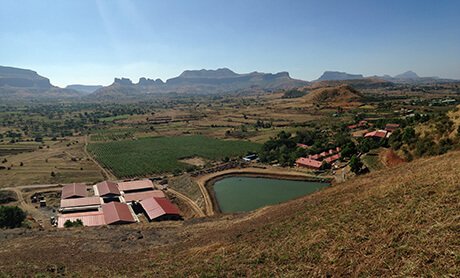Sankaracharya(788-820 A.D.) was bornin a family of Nambudiribrahman sect in a village called Kaladi in the State of Kerala. His parents were pious couple having deep religious culture. His father was a priest in a Shiva temple. In the times of Sankaracharya, there was no powerful king in south India; and this period noticed the rise of bhakti movement. Brahmans were the dominating group of people through their behaviour and divinely oriented life. He received necessary training in Vedic recital and study. He also attained proficiency in languages in his early age. His father died when he was only 7 years old. He exhibited extraordinary intelligence in his boyhood, mastering all the then-current theologies and philosophies by the age of 17. A number of miracles are associated with his life. One of which is as follows:
According to the divine wish,Sankaracharya had to become a religious teacher, Sannyasin; but his mother was not interested in it. One day it is said that a miracle happened: When he was taking bath in a nearby river, a crocodile caught hold of his leg and dragged him; his mother saw and cried. Then he asked his mother to give permission to take Sannyasin, so that the crocodile might leave him according to the divine wish. At this crucial hour his mother agreed, and he was released from the jaws of the crocodile dramatically. Thus he had become a Sannyasinto take up his chosen divine mission.
His mission was not to bring quarrel among various theological systems but to see that a sprit of unity prevails. He interpreted the theology of Upanisads and preached it for the benefit of humanity, as people are misguided with false doctrines. He travelled whole India. In his journey, it is said that he met many people including Govinda, and Gaudapada (who wrote verse commentaries on the Upanisads, the Bhagavad Gita and the Brahma Sutra in Benaras).
He was the greatest exponent of the doctrine of Advaita Vedanta. The existence of Vedic Dharma in India is due to him. The forces opposed to Vedic religion were more numerous and powerful at the time of Sankaracharya than they are today. Still single-handed, within a very short time, he overpowered them all and restored the Vedic Dharma and Advaita Vedanta. He occupies a very important position in the history of Indian philosophy. He laid the foundation of the propagation of Vedanta before the beginning of middle ages; and it was nourished by Ramakrishna Mission and Swami Vivekananda in the modern period. In order to preach the message of Advaita Vedanta, he established missionary centres (monasteries) in the four centres-Badarinath in Himalayas, Dvaraka in Gujarat, Puri in Orissa and Srngeri in Mysore. There are his great commentaries on three source books of Vedanta-the Vedanta Sutras, the Upanishads and the Bhagavad Gita.
Hinduism is a religion of many cults and different deities. At different places in India, various gods are worshipped according to the nature of the people. The form of worship also differs from one place to the other place. There are contradictions apparently but there is fundamental belief that the God, they worship is an incarnation, avatara of the Supreme Being, Brahman. The claim of Sankaracharya is that though Hinduism consists of several cults there should not be any conflict among them. He established a harmonious relation among various cults and therefore, he was called the establisher of the six faiths, sanmata-sthapak-acarya.
His teachings or the doctrine of AdvaitaVendantacan be summed up in a half a verse: "Brahma Satyam JaganMithyaJivoBrahmaiva Na Aprab (Brahman or the Absolute is alone real; this world is unreal; and the Jiva or the individual soul is non-different from Brahman)".Core teachings that arise from his works are:
Phone - +91-9822770727
E-mail - yoga@yogapoint.com or yogapoint108@gmail.com

Yoga Vidya Dham, Kaivalya Nagari,
College Road, Nashik - 422005.
Maharashtra, India.
Phone - +91-9822770727 (for courses in ENGLISH)
+91-253-2318090 (For courses, in HINDI or MARATHI)
(Please call during 9.00 AM to 5 PM Indian Time)
E-mail - yoga@yogapoint.co or yogapoint108@gmail.com
Village Talwade, Trimbak, Nasik
Maharashtra,India.
Phone - +91-9822770727
E-mail - yoga@yogapoint.com or yogapoint108@gmail.com